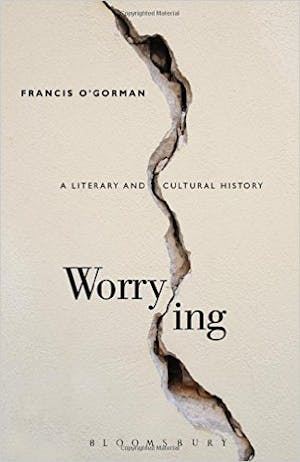YOLO is the antidote to FOMO. They are the two guiding principles of our time, the time after God’s death. Drunk on the idea that we are free and rational individuals—God caught his robe in a spinning jenny some time during the industrial revolution and lies mangled among the cogs and gears—we know that our destinies are up to us. And we only live once, because we don’t believe in heaven, so we must ensure that we do not miss out. YOLO and FOMO: our Castor and Pollux.
None of that is true. We love historical explanations for inexplicable feelings, and the above is a good example of a story defining an emotion according to its place in culture. This story, Francis O’Gorman explains, suggests that worry is a specially modern feeling, specially ours, because people in largely secular societies have to take full responsibility for their choices. As Austen’s heroines swooned because their corsets were too tight and bad weather enraged the underclass of eighteenth-century France, we are worried because we are too free.

In his highly anxious but very valuable new book Worrying: a Literary and Cultural History (Bloomsbury 2015), Francis O’Gorman, Professor of Victorian Literature at the University of Leeds, seeks to pin down worry as an idea and to record the stories we tell ourselves about it; he sets worrying in both its recent and its deeper cultural history, and he also contemplates the various ways writers and artists have dealt with worry as a category of experience. The “whole cultural myth of the ‘birth of reason,’ of the fantasized change from faith to thought as the guiding power of human lives,” he writes, is the most important and boring of these metanarratives. But the book leads us to stranger and more puzzling places, too.
To clarify, that specific place is the UK. God isn’t dead in the U.S., I don’t think, and in this country, clinical anxiety in the internet age would probably have become O’Gorman’s subject. The American public understands anxiety much more broadly, as it’s become a widely diagnosed and medicated category of illness over the last thirty years. Indeed, he refuses to name worry a pathology, and in so doing writes himself into the difficult position of having to dance between different models of history. Worrying isn’t quite the medical humanities, or quite psychohistory, or even, really, literary criticism:
What am I doing? I have daunting questions about how the category of “mental health” relates to worry; how worry relates to any new and fuller understanding of what we, in the modern world, should understand by “mental health” or “mental unhealth.”
Scott Stossel had a much easier time of it in his memoir My Age of Anxiety (2014): he recalled his struggles with a clearly defined mental illness. O’Gorman, on the other hand, is simply talking about a feeling which is clearly, to him, normal. O’Gorman’s “worry” is neither illness nor oeuvre but a feeling that he can only really define with reference to his own interiority:
These beats, taps, and twinges are, typically, something like a momentary worry about where my wallet is or whether the milk has run out in the fridge or whether I put a stamp on that letter I posted earlier in the morning. They’re tiny and fleeting. They are simply part of the pattern or texture of the worrier’s day—here and gone. But, while they look on paper like the regular thoughts of anyone during a regular day, these thoughts are attended for the worrier by something darker, more out-of-keeping with their apparent insignificance…. Even the most minor of troubles can, for the worrier—hurt.
For a British intellectual like him, when viewed in the longue durée, worry is in some sense the particular reprisal of the post-Enlightenment secularization of culture rather than a mental illness. It gets inside our minds from the outside. “With an affirmation of the importance and possibility of human choice, and on reasoning as a way of deciding the best options,” he writes of post-Enlightenment thought, “the mythic shift from faith to reason is the portal through which the insomniac, drained shape of worry has slipped.” (He also calls worry an “ashen figure,” “a bat,” and “a rough patch of land, covered with clumps of nettles and broken Muscadet bottles”).
Indeed “worry’s histories,” O’Gorman continues, “are to do with nothing less than the structure of the modern world.” Worry was only really born in the nineteenth century, he argues, beginning “to appear in imaginative accounts of human lives at the end of the Victorian period.” As a support, O’Gorman cites Rudyard Kipling’s Dick Heldar, protagonist of the gloomy 1891 novel The Light that Failed: “I’m only a bit worried about things in general,” Heldar says. This kind of nebulous, ambient worry was simply not present in the literature of earlier periods. Of course he doesn’t mean that Hamlet wasn’t a worried chap—he means that the word itself was not used in quite that sense. Specifically, the intransitive sense of worry to mean feeling anxious or troubled is a post-1860 development. Before, the verb only meant to worry at a thing in a toothful way, as when a lion worries her quarry. Kipling’s Heldar, however, is a subject who worries generally, not at an object. Then, in the early twentieth century, O’Gorman argues, worry emerged “as a familiar but also awkward category of experience.” This tracing—semantic meaning to literary theme to category of experience—is a clue that a single emotion may hold keys to understanding the broader scaffolding holding our inner lives together.
Of course, circumstantial clues like these can be a terrible temptation for the historian. Explanatory power is what we’re all after: See everything in just this light and things make perfect sense. But when O’Gorman takes his argument into the twentieth century, working up a quartet of self-help, World War I, literary modernism, and choice theory, it really gets compelling.
Directly after the First World War, the self-help manual market exploded, presumably because everybody in Europe was dead or traumatized. It had become a world of Dick Heldars. As “worry began to appear on the book shelves,” O’Gorman writes, “it was ironically clear that it was here to stay.” If self-help books worked to banish worry, one generation of them should have been enough. Take William S. Sadler’s Worry and Nervousness or The Science of Self-Mastery (1914), an early and little-remembered self-help volume. Sadler defines “chronic fear,”—i.e., worry—as “a purely psychic condition characterized by inability to relax the attention when it has once fastened itself on a given idea—usually a persistently entertained fear of some sort.” Strangely paradoxical stuff, and not very helpful either. Rather than offering practical strategies Sadler seemed to think that, if one could understand what ailed you, you might find relief.
Darkly mirroring this sort of talk, the arcane rituals of worry and doubt formed strange twentieth century magics—T. S. Eliot, Virginia Woolf, and James Joyce all stretched worry over big frames to make ambitious art about what it is like to live inside a mind. O’Gorman’s thoughts on modernism connect very well with his original theory about freedom and choice: Worry is liberty’s handmaiden, and so the most untethered artistic forms will generally take it as their subject.
In a pretty big jump in subject matter towards the book’s end, O’Gorman turns to William Glasser’s Choice Theory: A New Psychology of Personal Freedom (1998) to address how the language of choice can turn insidious. In the book, Glasser takes “the free market as far as it could go in relation to individual identity.” It is a self-help book much like William S. Sadler’s, but one written at “the last frontier of the crossover between the language of choice, the discourse of ‘liberty,’ and the sources of human happiness,” according to O’Gorman. By simply juxtaposing choice theory with literary treatments of worry, O’Gorman assembles a pretty powerful critique of the neoliberal theory of mind. Glasser’s total belief in the ability to choose our fates—excepting the influence of our genes, “all we do is behave”—is “a kind of extreme expression of the political right” and simultaneously a horribly deceptive perspective on mental health. You’ve got nobody to blame but yourself, choice theory says. Worry you will.
So: Ideological freedom may have led us to worry, but the new ideology of individual liberty leads us right back to a conception of choice that denies the nature of human suffering. The mentally ill do not choose their agonies. The belief that they do is, as O’Gorman points out, “a tenacious political assumption of our advanced capitalism.” It points directly back to the belief that a Hegelian spirit inhabits history, marching us forward towards enlightenment, reason, and civilization (the white kind, of course).
We can follow worry’s roots down into the epistemological ground beneath our feet. Going back to our dead-dad-in-the-sky: The modern world is built with “shifts in the understanding of the rules by which human beings make decisions; with the drift of the West towards the secular; with the dislodging and relocation of faith and what we believe in and what we think faith does.” In other words, the very concept of freedom relies on the individual’s liberation from religious predestination into the beautiful new world of J. S. Mill-flavored rationality. The political concept of freedom gets inside our heads. It is a social principle, but it structures our interiority. This liberty worries us; it extends to the realm of culture too, touching the arts as much as it touches the individual human heart and mind.
In this way, O’Gorman joins the tide of humanities scholars linking their discipline with the history of emotion, sensory experience, and illness. It’s an approach to culture most interested in human interiority and the heuristics that govern the interpretation of experience: Happiness can be studied; sound can be thought through; feeling can be data.
Worrying also fits into the tradition of breaking down myths and tropes into discrete units, a bit like Mircea Eliade’s Myth and Reality or C. S. Lewis’ Studies in Words. We care about these books because we need stories about the cultural past so that we might have a sense of ourselves in time. The real value of O’Gorman’s book lies, I think, in the way it flags the politics of the stories we tell ourselves. In its attribution of emotional drives to the ideas behind modernist culture and neoliberal politics alike, Worrying shows that their architects—white writers, mostly—are as much victims of emotion as masters of thought. If we can see the emotional impulses behind our definitions of rationality, liberty, and literary craftsmanship, we can understand our own moment in cultural time more accurately and more fairly: Perhaps we can become our own gods, after all.
